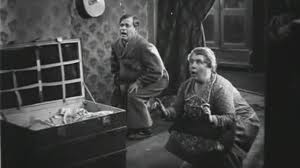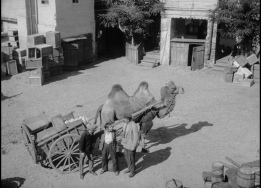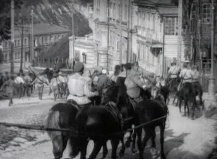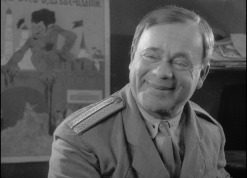Ukrainian Institute/London School of Economics, London
30 May 2017
 This evening saw us at the London School of Economics, perhaps not the most likely venue for a silent film screening. But they were hosting one of a number of events being presented by the Ukrainian Institute in London as part of a series to mark “A Century of Ukrainian Revolutions: 1917-2017”. The screening was preceded by a presentation ‘Why the Ukrainian Revolution Matters for Historians of the Russian Revolutions’ by US Slavic Studies Academic Professor Mark von Hagen.
This evening saw us at the London School of Economics, perhaps not the most likely venue for a silent film screening. But they were hosting one of a number of events being presented by the Ukrainian Institute in London as part of a series to mark “A Century of Ukrainian Revolutions: 1917-2017”. The screening was preceded by a presentation ‘Why the Ukrainian Revolution Matters for Historians of the Russian Revolutions’ by US Slavic Studies Academic Professor Mark von Hagen.
Made in 1929, Shkurnik follows the adventures of Apollon ‘Shkurnik’ Shmyguyev, an easy-going bourgeois resident of Kiev, always looking for ways to turn a quick profit. The film opens with him,  keenly egged on by his wife (left), trying to secure a cargo of sugar from a disabled cart during the Bolshevik Red forces’ occupation of the city during the 1917-21 Civil War. But before he can ‘liberate’ the goods two Red soldiers turn up with a camel to retrieve the cart and Apollon is forced to drive it for them as the Red forces flee the city. He is then arrested by the Reds for being a sugar ’profiteer’. But as the Red Forces’ Emergency Food Distribution committee grows in number discussing at great length how best to distribute the sugar, the enterprising local villagers manage to distract Apollon’s guards and buy the sugar off him. He hides the money they have given him in a bag of straw but while he is away the camel eats the straw and the money!. With no sugar to incriminate him Apollon is freed but is quickly captured by
keenly egged on by his wife (left), trying to secure a cargo of sugar from a disabled cart during the Bolshevik Red forces’ occupation of the city during the 1917-21 Civil War. But before he can ‘liberate’ the goods two Red soldiers turn up with a camel to retrieve the cart and Apollon is forced to drive it for them as the Red forces flee the city. He is then arrested by the Reds for being a sugar ’profiteer’. But as the Red Forces’ Emergency Food Distribution committee grows in number discussing at great length how best to distribute the sugar, the enterprising local villagers manage to distract Apollon’s guards and buy the sugar off him. He hides the money they have given him in a bag of straw but while he is away the camel eats the straw and the money!. With no sugar to incriminate him Apollon is freed but is quickly captured by  the White forces who accuse him of being a Red spy and put him in front of a firing squad where he is saved by the camel. Recognised by a friendly relative amongst the White forces he is put in charge of their Intelligence and Propaganda cell. But just as he is beginning to charm the ladies (right) in his section he is recaptured by the Reds. Now working in their Agitprop section (left), he is caught out by the Red Commissar making illegal alcohol (having failed to get the camel to drink the evidence!) and jailed.
the White forces who accuse him of being a Red spy and put him in front of a firing squad where he is saved by the camel. Recognised by a friendly relative amongst the White forces he is put in charge of their Intelligence and Propaganda cell. But just as he is beginning to charm the ladies (right) in his section he is recaptured by the Reds. Now working in their Agitprop section (left), he is caught out by the Red Commissar making illegal alcohol (having failed to get the camel to drink the evidence!) and jailed.  Escaping once more he falls into the hands of bandits but is once again saved by discovering amongst their number another relative who vouches for him and Apollon looks to get a share of the bandit’s ill-gotten jewellery and valuables. But when the Red forces attack the bandits, using an artillery piece pulled by the camel, Apollon is once again captured and faces an uncertain future while the camel is hailed as a hero of labour by the Red Forces.
Escaping once more he falls into the hands of bandits but is once again saved by discovering amongst their number another relative who vouches for him and Apollon looks to get a share of the bandit’s ill-gotten jewellery and valuables. But when the Red forces attack the bandits, using an artillery piece pulled by the camel, Apollon is once again captured and faces an uncertain future while the camel is hailed as a hero of labour by the Red Forces.
While the above synopsis really catches only the bare bones of what is a most complicated story of repeated capture, escape and recapture, Shkurnik is a most enjoyable film on a number of levels. At one level, it’s an almost Chaplin-esque comedy with under- and over-cranked camera work to highlight some of the pratfalls and physical comedy or, for example, when the camel eats the money  or tries to drink the hooch. But at another level, it is also a biting satire on the political attitudes and beliefs prevalent at the time it was made. In particular, Apollon is labelled a ‘philistine’, taking aim at those similarly labelled in the late 1920s, the entrepreneurs of the petit bourgeois who sought to take advantage of the partial and time-limited return to a capitalist system in the Soviet Union during the period of the New Economic Policy (NEP). It is also a scathing attack on the bureaucracy of the Soviet system, portrayed so beautifully in the scenes where the Emergency Food Distribution committee gradually grows in size and verbosity as it attempts to find an equitable way to distribute the sugar, while the more savvy villagers get on with ‘distributing’ the sugar amongst themselves far more quickly and effectively (right). And yet at another level, the film could almost be seen as a pastiche of the work of other contemporary Soviet film-makers. The beautifully filmed scenes of the rippling wheat fields across which Apollon escapes or the workers toiling to bring in the harvest are reminiscent of
or tries to drink the hooch. But at another level, it is also a biting satire on the political attitudes and beliefs prevalent at the time it was made. In particular, Apollon is labelled a ‘philistine’, taking aim at those similarly labelled in the late 1920s, the entrepreneurs of the petit bourgeois who sought to take advantage of the partial and time-limited return to a capitalist system in the Soviet Union during the period of the New Economic Policy (NEP). It is also a scathing attack on the bureaucracy of the Soviet system, portrayed so beautifully in the scenes where the Emergency Food Distribution committee gradually grows in size and verbosity as it attempts to find an equitable way to distribute the sugar, while the more savvy villagers get on with ‘distributing’ the sugar amongst themselves far more quickly and effectively (right). And yet at another level, the film could almost be seen as a pastiche of the work of other contemporary Soviet film-makers. The beautifully filmed scenes of the rippling wheat fields across which Apollon escapes or the workers toiling to bring in the harvest are reminiscent of  Dovzhenko’s Earth (released in 1930 but filmed the preceding year) while scenes of machinery in motion are suggestive of (and as impressive as) Vertov and Kaufman’s work on Man With a Movie Camera (1929).
Dovzhenko’s Earth (released in 1930 but filmed the preceding year) while scenes of machinery in motion are suggestive of (and as impressive as) Vertov and Kaufman’s work on Man With a Movie Camera (1929).
Sadly, for director Nikolai Shpikovsky it was the film’s satirical content that gave offence to the Soviet authorities (this despite its at least equally scathing portrayal of the White Russian cause). Within a week of it being screened, the film had been banned, described in report No. 2974 of the Senior Repertoire Committee of the Russian Soviet Federative Socialist Republic, dated 27 April 1929: “The Civil War is presented in the film only in terms of its dark ugly side. It shows only robbery, dirt, the stupidity of the Red Army and the local Soviet authorities, etc. As a result, a nasty lampoon on the reality of that time was produced.” And so, the film would remain hidden on the shelves of the State Film Fund in Moscow for more than half a century until it was rediscovered in the 1990s. In 2011, the film was restored by the Dovzhenko  National Film Studios and the restored film with a newly composed soundtrack was premiered with accompaniment by full orchestra at the 42nd Youth International Film Festival in Kiev in October 2012.
National Film Studios and the restored film with a newly composed soundtrack was premiered with accompaniment by full orchestra at the 42nd Youth International Film Festival in Kiev in October 2012.
The quality of restored version of the film that we watched tonight was absolutely breath-taking, with not a scratch or a blemish to  mar its presentation. This served to further highlight the film’s beautiful cinematography and the often-stunning images portrayed. It wasn’t clear whether this version came with the soundtrack composed for the 2012 screening but what was interesting was the extensive use of sound effects within the soundtrack. Although I have seen other restored silent films which utilise occasional sound effects to highlight particularly significant events on-screen, this soundtrack included sound effects synchronised to match virtually every on-screen happening. This had the slightly disorienting effect, initially at least, of making you think you were watching not a silent, but rather a sound film, just one without dialogue. Also, although the sound effects were synchronised
mar its presentation. This served to further highlight the film’s beautiful cinematography and the often-stunning images portrayed. It wasn’t clear whether this version came with the soundtrack composed for the 2012 screening but what was interesting was the extensive use of sound effects within the soundtrack. Although I have seen other restored silent films which utilise occasional sound effects to highlight particularly significant events on-screen, this soundtrack included sound effects synchronised to match virtually every on-screen happening. This had the slightly disorienting effect, initially at least, of making you think you were watching not a silent, but rather a sound film, just one without dialogue. Also, although the sound effects were synchronised  perfectly at the beginning, as the film went on they became slightly out of synch although this only marginally impacted on my overall enjoyment of this film.
perfectly at the beginning, as the film went on they became slightly out of synch although this only marginally impacted on my overall enjoyment of this film.
Amongst the cast, Ivan Sadovski was excellent as the long-suffering Apollon (right), always facing another setback in his bourgeoise schemes to get rich, while hastily changing uniform to blend in, be it with Reds, Whites or bandits. I can find out nothing more about him other than that he was still making  films in 1940 before his eventual death in 1948. Dora Feller-Shpikovskava (left) was also good as the female Red Commissar while the film was uniformly packed with the most amazingly characterful faces, be they farm peasants, aging White generals or hard-bitten bandits. Oh, and the un-named camel deserved praise also for his highly entertaining role.
films in 1940 before his eventual death in 1948. Dora Feller-Shpikovskava (left) was also good as the female Red Commissar while the film was uniformly packed with the most amazingly characterful faces, be they farm peasants, aging White generals or hard-bitten bandits. Oh, and the un-named camel deserved praise also for his highly entertaining role.
Director Shpikovsky made a very positive start to his film career with the well received and very funny short Chess Fever (1925), co-directed with Vsevolod Pudovkin. He appeared to prosper under the relative freedom and avant-garde direction of the All-Ukrainian Photo-Cinema Directorate (VUFKU). But after Shkurnik, Shpikovsky had two further films banned by the Soviet authorities in Moscow, Bread (1929) and Hegemon (1931). Following this he appears to have given up film directing altogether, returning to Moscow to work simply as a scriptwriter. He died in 1977, long before his films were re-discovered, restored and so positively reappraised.
Although Shkurnik was screened at the Pordenone Silent Film Festival in 2013 it remains almost unknown outside the Ukraine so this was a very welcome opportunity to catch up with such a silent film rarity. I can find no indication as to whether the film is available on DVD but it would be a nice one to acquire as it is a film that would well justify another look and one which cries out to be more widely known.
Sources;
https://cinetext.wordpress.com/category/soviet-film/
http://anttialanenfilmdiary.blogspot.co.uk/2013/10/shkurnyk-self-seeker-2011-digital.html
https://www.themoviedb.org/movie/235575-shkurnyk
http://www.kinoglaz.fr/u_fiche_film.php?num=7090
